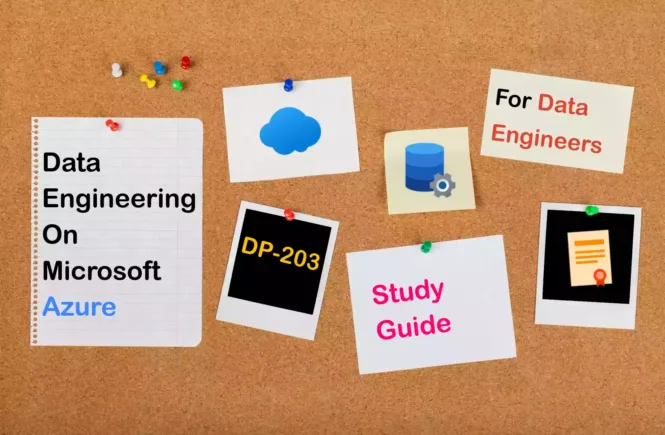DP-203 Preparation Details
Preparing for the DP-203 Data Engineering on Microsoft Azure exam? Don’t know where to start? This post is the DP-203 Certificate Study Guide, which helps you to achieve the Azure Data Engineer Associate Certification.
I have curated a list of articles from Microsoft documentation for each objective of the DP-203 exam. Please share the post within your circles so it helps them to prepare for the exam.
Exam Voucher for DP-203 with 1 Retake
Get 40% OFF with the combo
DP-203 Data Engineering on Azure Course
| Pluralsight | Data Engineering on Azure (with labs) |
| Resources from LinkedIn | Azure Databricks Essentials / Cosmos DB |
| Udemy | Implementing Azure Data Exam Prep |
DP-203 Practice Test for Azure Data Engineer
| Whizlabs Exam Questions | 3 Practice Tests (130 Practice Questions) |
| Udemy Practice Tests | Implementing an Azure data exam |
DP-203 Azure Data Engineer Other Materials
| Udacity (Nanodegree) | Become a Data Engineer (Nanodegree) |
| Coursera specialization | Data Engineering Associate Exam Prep |
| Amazon e-book (PDF) | Azure Data Engineer: Data WH & Data Factory |
DP-203 Sample Practice Exam Questions
Looking for DP-203 Dumps? Read This!
Using DP-203 exam dumps can get you permanently banned from taking any future Microsoft certificate exam. Read the FAQ page for more information. However, I strongly suggest you validate your understanding with practice questions.
Check out all the other Azure certificate study guides
Full Disclosure: Some of the links in this post are affiliate links. I receive a commission when you purchase through them.
Design and Implement Data Storage (40-45%)
Design a Data Storage Structure
Design an Azure Data Lake solution
Introduction to Azure Data Lake Storage Gen2
Building your Data Lake on Azure Data Lake Storage gen2
Recommend file types for storage
Example scenarios for core Azure Storage services
Recommend file types for analytical queries
Query data in Azure Data Lake using Azure Data Explorer
Query Azure Storage analytics logs in Azure Log Analytics
Design for efficient querying
Design Azure Table storage for queries
Design for data pruning
Design a folder structure that represents the levels of data transformation
Copy & transform data in Data Lake Storage using Azure Data Factory
Design a distribution strategy
How to choose the right data distribution strategy for Azure Synapse?
Guidance for designing distributed tables in Azure Synapse
Design a data archiving solution
Designing a data archiving strategy on Microsoft Azure
Solution architecture: Archive on-premises data to the cloud
Design a Partition Strategy
Design a partitioning strategy for files
File Partition using Azure Data Factory
Incrementally copy new files by using the Copy Data tool
Design a partitioning strategy for analytical workloads
Best practices for Azure Databricks
Automated Partition Management with Azure Analysis Services
Design a partitioning strategy for efficiency/performance
Designing partitions for query performance
Design a partitioning strategy for Azure Synapse Analytics
Partitioning tables in Azure Synapse Analytics
Identify when partitioning is needed in Azure Data Lake Storage Gen2
Design the Serving Layer
Design star schemas
Design slowly changing dimensions
Design a Slowly Changing Dimension (SCD) in Azure Data Factory
Design a dimensional hierarchy
Simple hierarchical dimensions
Design a solution for temporal data
Getting started with temporal tables in Azure SQL Database
Design for incremental loading
Incrementally load data from a source to a destination datastore
Incrementally load data from Azure SQL Database to Blob storage
Design analytical stores
Choosing an analytical data store in Azure
Azure Cosmos DB analytical store
Design meta stores in Azure Synapse Analytics and Azure Databricks
Azure Synapse Analytics shared metadata tables
Manage Apache Hive metastore for Databricks
Implement Physical Data Storage Structures
Implement compression
Data compression in Azure SQL Database
Forum discussion on compression in Azure SQL DB
Implement partitioning
How to partition your data in Azure Cosmos DB?
Implement sharding
Sharding patterns and strategies
Adding a shard using Elastic Database tools
Implement different table geometries with Azure Synapse Analytics pools
Table data types for dedicated SQL pool
Implement data redundancy
Change how a storage account is replicated
Implement distributions
Distributions in Azure Synapse Analytics
Examples for table distribution
Implement data archiving
Archive on-premises data to the cloud
Rehydrate blob data from the archive tier
Implement Logical Data Structures
Build a temporal data solution
Creating a system-versioned temporal table
Build a slowly changing dimension
Azure Data Factory Data Flow: Building Slowly Changing Dimensions
How to implement Slowly Changing Dimension Type 1?
Slowly Changing Dim Type 2 with ADF Mapping Data Flows
Build a logical folder structure
Creating an Azure Blob Hierarchy
Modeling a directory structure on Azure Blob Storage
Build external tables
Use external tables with Synapse SQL
Create external tables in Azure Storage / Azure Data Lake
Implement file and folder structures for efficient querying and data pruning
Query multiple files or folders
Query folders and multiple files
Implement the Serving Layer
Deliver data in a relational star schema
Data models within Azure Analysis Services
Deliver data in Parquet files
Parquet format in Azure Data Factory
Parquet format in Azure Data Lake Analytics
Maintain metadata
Preserve metadata using copy activity in Azure Data Factory
Implement a dimensional hierarchy
Amazon link (affiliate)
Design and Develop Data Processing (25-30%)
Ingest and Transform Data
Transform data by using Apache Spark
Transform data in the cloud by using a Spark activity in ADF
Transform data using Spark activity in Azure Data Factory
Transform data by using Transact-SQL
Apply SQL Transformation in AML
Transform data by using Data Factory
Transform data in Azure Data Factory
Transform data using mapping data flows
Transform data by using Azure Synapse Pipelines
Use Azure Synapse Analytics to create a pipeline for data transformation
Transform data by using Stream Analytics
Transform data by using Azure Stream Analytics
Cleanse data
Split data
Shred JSON
JSON in your Azure SQL Database? Let’s benchmark some options!
Encode and decode data
Azure Data Factory copy activity with Base64 encoded string
Handling data encoding issues while loading data to SQL Data Warehouse
Configure error handling for the transformation
Handle SQL truncation error rows in Data Factory mapping data flows
Troubleshoot mapping data flows in Azure Data Factory
Normalize and denormalize values
How do I denormalize data in Azure Machine Learning Studio?
Transform data by using Scala
ETL by using Azure Databricks & Scala
Perform data exploratory analysis
Exploratory Data Analysis with Azure Synapse Analytics
Perform EDA in Azure Data Explorer with Web UI
Design and Develop a Batch Processing Solution
Develop batch processing solutions by using Data Factory, Data Lake, Spark, Azure Synapse Pipelines, PolyBase, and Azure Databricks
Choosing a batch processing technology in Azure
Building batch data processing solutions in Microsoft Azure
Create data pipelines
Create a pipeline in Azure Data Factory
Build a data pipeline by using ADF, DevOps, & Machine Learning
Design and implement incremental data loads
Load data incrementally from Azure SQL Database to Blob storage
Implement incremental data loading with ADF
Incremental data loading using Azure Data Factory
Design and develop slowly changing dimensions
Processing Slowly Changing Dimensions with ADF Data Flows
Handle security and compliance requirements
Azure security baseline for Batch
Policy Regulatory Compliance controls for Azure Batch
Scale resources
Automatically scale compute nodes in an Azure Batch pool
Configure the batch size
Choose a VM size & image for compute nodes
Design and create tests for data pipelines
Unit testing Azure Data Factory pipelines
Integrate Jupyter/IPython notebooks into a data pipeline
Set up a Python development environment for AML
Explore Azure Machine Learning with Jupyter Notebooks
Handle duplicate data
Handle duplicate data in Azure Data Explorer
Dedupe rows by using data flow snippets
Handle missing data
Methods for handling missing values
Handle late-arriving data
Upsert data
Optimize Azure SQL Upsert scenarios
Implement Upsert using Dataflow
Regress to a previous state
Monitor Batch solutions by counting tasks & nodes by state
Design and configure exception handling
Error handling and detection in Azure Batch
Configure batch retention
Design a batch processing solution
Debug Spark jobs by using the Spark UI
Debug Apache Spark jobs with the Spark UI
Design and Develop a Stream Processing Solution
Develop a stream processing solution by using Stream Analytics, Azure Databricks, and Azure Event Hubs
Implement a data streaming solution with Azure Streaming Analytics
Stream processing with Azure Databricks
Stream data into Azure Databricks using Event Hubs
Process data by using Spark structured streaming
Overview of Apache Spark Structured Streaming
Monitor for performance and functional regressions
Understand Stream Analytics job monitoring
Design and create windowed aggregates
Introduction to Stream Analytics windowing functions
Windowing functions (Azure Stream Analytics)
Handle schema drift
Schema drift in the mapping data flow
Process time-series data
Understand time handling in Azure Stream Analytics
Process across partitions
Stream processing with Azure Stream Analytics
Use repartitioning to optimize processing with Stream Analytics
Process within one partition
Maximize throughput with repartitioning
Configure checkpoints/watermarking during processing
Checkpoints in Azure Stream Analytics jobs
Scale resources
Understand and adjust Streaming Units
Scale an Azure Stream Analytics job to increase throughput
Design and create tests for data pipelines
Test live data locally using Azure Stream Analytics tools
Test an Azure Stream Analytics job in the portal
Optimize pipelines for analytical or transactional purposes
Use repartitioning to optimize processing
Leverage query parallelization
Handle interruptions
Avoid service interruptions in Azure Stream Analytics jobs
Design and configure exception handling
Azure Stream Analytics output error policy
Exception handling in Azure Stream Analytics
Upsert data
Azure Stream Processing upsert to DocumentDB
Replay archived stream data
Design a stream processing solution
Stream processing with Azure Stream Analytics
Manage Batches and Pipelines
Trigger batches
Trigger a Batch job using Azure Functions
Handle failed batch loads
Check for pool and node errors
Validate batch loads
Manage data pipelines in Data Factory/Synapse Pipelines
Monitor and manage Azure Data Factory pipelines
Managing the mapping data flow graph
Schedule data pipelines in Data Factory/Synapse Pipelines
Create a trigger that runs a pipeline on a schedule
Implement version control for pipeline artifacts
Source control in Azure Data Factory
Manage Spark jobs in a pipeline
Monitor a pipeline with Spark activity
Design and Implement Data Security (10-15%)
Design Security for Data Policies and Standards
Design data encryption for data at rest and in transit
Azure Storage Encryption for data at rest
Design a data auditing strategy
Auditing for Azure SQL Database & Synapse Analytics
Design a data masking strategy
Static Data Masking for Azure SQL Database
Design for data privacy
Data privacy in the trusted cloud
Design a data retention policy
Understand data retention in Azure Time Series Insights
Design to purge data based on business requirements
Enable data purge on your Azure Data Explorer cluster
Design Azure role-based access control (Azure RBAC) and POSIX-like Access Control List (ACL) for Data Lake Storage Gen2
Role-based access control (Azure RBAC)
Access control lists in Azure Data Lake Storage Gen2
Design row-level and column-level security
Row-level security in Azure SQL Database
Implement Data Security
Implement data masking
Get started with SQL Database dynamic data masking
Encrypt data at rest and in motion
Transparent data encryption for SQL Database
Implement row-level and column-level security
Row-level security in Azure SQL Database
Implement Azure RBAC
Use the portal to assign a role for access to blob & queue data
Implement POSIX-like ACLs for Data Lake Storage Gen2
Use PowerShell to manage ACLs in Data Lake Storage Gen2
Implement a data retention policy
Configuring retention in Azure Time Series Insights
Implement a data auditing strategy
Set up auditing for your server
Manage identities, keys, and secrets across different data platform technologies
Manage keys, secrets, for secure data with Key Vault
Implement secure endpoints (private and public)
Use private endpoints for Azure Storage
Use Azure SQL MI securely with public endpoints
Configure public endpoint in Managed Instance
Implement resource tokens in Azure Databricks
Authentication using Databricks personal access tokens
Load a DataFrame with sensitive information
Write encrypted data to tables or Parquet files
Use Parquet with Azure Data Lake Analytics
Manage sensitive information
Security Control: Data protection
Monitor and Optimize Data Storage and Data Processing (10-15%)
Monitor Data Storage and Data Processing
Implement logging used by Azure Monitor
Collect custom logs with Log Analytics agent in Azure Monitor
Configure monitoring services
Monitoring Azure resources with Azure Monitor
Enable Azure Monitor for VMs overview
Measure the performance of data movement
Copy activity performance and scalability guide
Monitor and update statistics about data across a system
Update statistics in Synapse SQL
Update Statistics (Transact-SQL)
Monitor data pipeline performance
Monitor and alert Data Factory by using Azure Monitor
Measure query performance
Query Performance Insight for Azure SQL Database
How to measure the performance of the Azure SQL DB?
Monitor cluster performance
Monitor cluster performance in Azure HDInsight
Understand custom logging options
Collect custom logs with Log Analytics agent in Azure Monitor
Schedule and monitor pipeline tests
How to monitor & manage big data pipelines with ADF?
Monitor and manage Azure Data Factory pipelines
Interpret Azure Monitor metrics and logs
Azure Monitor Metrics overview
Overview of Azure platform logs
Interpret a Spark directed acyclic graph (DAG)
Directed Acyclic Graph DAG in Apache Spark
Understanding your Apache Spark application through visualization
Optimize and Troubleshoot Data Storage and Data Processing
Compact small files
Rewrite user-defined functions (UDFs)
Handle skew in data
Handle data spill
Data security Q&A (See Question 7)
Tune shuffle partitions
Use Unravel to tune Spark data partitioning
Find shuffling in a pipeline
Lightning-fast query performance with Azure SQL Data Warehouse
Optimize resource management
How to optimize your Azure environment?
Azure resource management tips to optimize a cloud deployment
Tune queries by using indexers
Automatic tuning for SQL Database
Tune queries by using cache
Performance tuning with a result set caching
Optimize pipelines for analytical or transactional purposes
Hyperspace: An indexing subsystem for Apache Spark
Optimize pipeline for descriptive versus analytical workloads
Optimize Apache Spark jobs in Azure Synapse Analytics
Troubleshoot a failed spark job
Troubleshoot Apache Spark by using Azure HDInsight
Troubleshoot a slow or failing job on an HDInsight cluster
Troubleshoot a failed pipeline run
Troubleshoot pipeline orchestration in Azure Data Factory
That’s it! This completes the DP-203 Data Engineering on Microsoft Azure Certification Study Guide.
What do you think? Let me know in the comments section if I have missed out on anything. Also, I love to hear from you about how your preparation is going on!
In case you are preparing for other Azure certification exams, check out the Azure study guide for those exams.
Follow Me to Receive Updates on DP-203 Exam
Want to be notified as soon as I post? Subscribe to the RSS feed / leave your email address in the subscribe section. Share the article to your social networks with the below links so it can benefit others.







